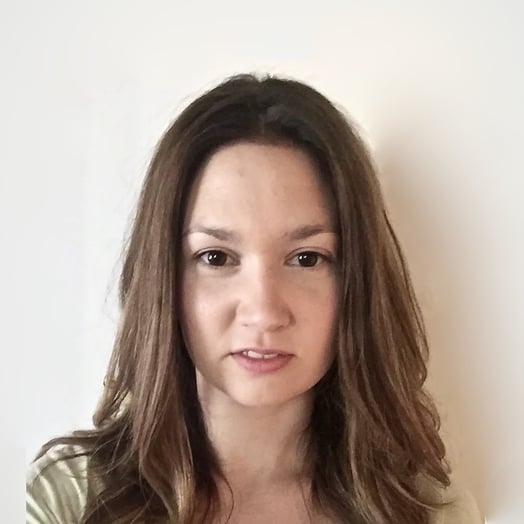
Ivana Milovanovic
Verified Expert in Engineering
Software Developer
Ivana holds a Ph.D. degree in electrical engineering. In her research at the University of Washington, she applies machine learning and statistical signal processing to the development of brain-computer interfaces. Being a data scientist with a robust mathematical-and-engineering background, Ivana can tackle complex problems involving large volumes of data using machine learning and statistical analysis.
Portfolio
Experience
Availability
Preferred Environment
Visual Studio Code (VS Code), PyCharm, Subversion (SVN), Git, Linux, Windows
The most amazing...
...project I've worked on was statistical modeling of neural activity from a single brain hemisphere to show that it can be used to control both sides of the body.
Work Experience
Insight Data Science Fellow
Insight Data Science Program
- Developed a machine learning algorithm that automatically identifies the best photo in a burst.
- Implemented and trained a pair-wise SVM ranker that uses general image quality features (blurriness, contrast, and more) and content-quality features (OpenCV for face detection, eyes open, and so on).
- Achieved 74% accuracy, measured using normalized discounted cumulative gain (NDCG).
- Deployed an interactive web app on AWS using Python, Flask, HTML, and CSS.
- Developed a multi-label text-classification algorithm to automatically tag research papers.
- Implemented a feature-extraction algorithm for NLP that uses TF-IDF of word n-grams, the appearance of words in a title, and more.
- Compared several problem transformation methods used in multi-label classification, including binary relevance, classifier chains, and label powerset.
Senior Postdoctoral Fellow
University of Washington
- Explored the possibility of using neural activity from a single brain hemisphere to control both sides of the body in a brain-computer interface paradigm.
- Analyzed terabytes of neural activity data to provide insight into the brain’s function.
- Applied advanced statistical modeling, including transfer entropy and Gaussian process factor analysis (GPFA) to assess brain connectivity.
- Published two peer-reviewed publications, four oral presentations, and two conference papers.
- Independently led a research project to allow retraining of proprioceptive sensory pathways in stroke and spinal cord injury patients.
- Built haptic devices to explore alternative methods of communicating arm position in space.
- Wrote a grant proposal incorporating my findings from this study which was awarded $90,000 by the Bayley Family Foundation.
Research Associate
University of Belgrade School of Electrical Engineering
- Analyzed the walking deficits in patients with stroke and Parkinson’s disease.
- Developed a method for quantifying pathological walking patterns in stroke patients.
- Demonstrated that principal component analysis (PCA) provides better insight into the specific differences between acute and chronic patients compared to clinically-used assessment metrics.
- Detected walking disturbances in Parkinson’s disease patients by combining a neural network and rule-based classification, achieving 84% accuracy.
Experience
PerfectShot | Find the Best Photo in a Burst
These days we all take tons of photos. With high quality digital cameras on our phones and endless cloud storage, we rarely ever take a single shot of anything anymore. But, every time we do that, we end up having multiple, redundant shots and going through photos and choosing which to keep is a time-consuming, tedious process. What if we could use ML to automatically select your best photos from the bunch you took?
I have developed a SVM ranker which uses both general image quality and content quality features to find the best photo. The app was deployed on AWS using Python, Flask, HTML, and CSS.
Abstract Tagger
This problem is a supervised text classification problem, and I have explored several different classifiers and problem transformation methods to see which one works best for the given scenario.
I've implemented a feature extraction algorithm for NLP that uses TF-IDF of word n-grams, the appearance of words in a title, and so on. I have explored problem transformations such as binary relevance, classifier chain,s and label powerset.
Reconfiguration of Neural Circuits
This is incredibly important for people who've had a stroke, where one side of the brain is partially or fully damaged. To answer this question, I analyzed terabytes of neural activity data to provide insight into the brain's function. I then used advanced statistical methods to model this activity and relate it to behavioral data.
Skills
Languages
Python 2, Python 3, C, Bash Script, Python, SQL, Bash, Simulink
Libraries/APIs
TensorFlow, Scikit-learn, OpenCV, Natural Language Toolkit (NLTK), Matplotlib, Pandas, OpenGL
Tools
MATLAB, Git, Subversion (SVN), PyCharm
Platforms
Jupyter Notebook, Windows, Linux, Amazon Web Services (AWS), Amazon EC2, Visual Studio Code (VS Code)
Other
Clustering, Classification, Regression, Signal Processing, Computer Vision, Natural Language Processing (NLP), GPT, Generative Pre-trained Transformers (GPT)
Frameworks
Flask
Storage
MySQL
Education
Ph.D. Degree in Biomedical Engineering
University of Belgrade School of Electrical Engineering - Belgrade, Serbia
Master's Degree in Electrical Engineering
University of Belgrade School of Electrical Engineering - Belgrade, Serbia
Certifications
Natural Language Processing in TensorFlow
Coursera
Introduction to TensorFlow for Artificial Intelligence, Machine Learning, and Deep Learning
Coursera
Convolutional Neural Networks in TensorFlow
Coursera
How to Work with Toptal
Toptal matches you directly with global industry experts from our network in hours—not weeks or months.
Share your needs
Choose your talent
Start your risk-free talent trial
Top talent is in high demand.
Start hiring